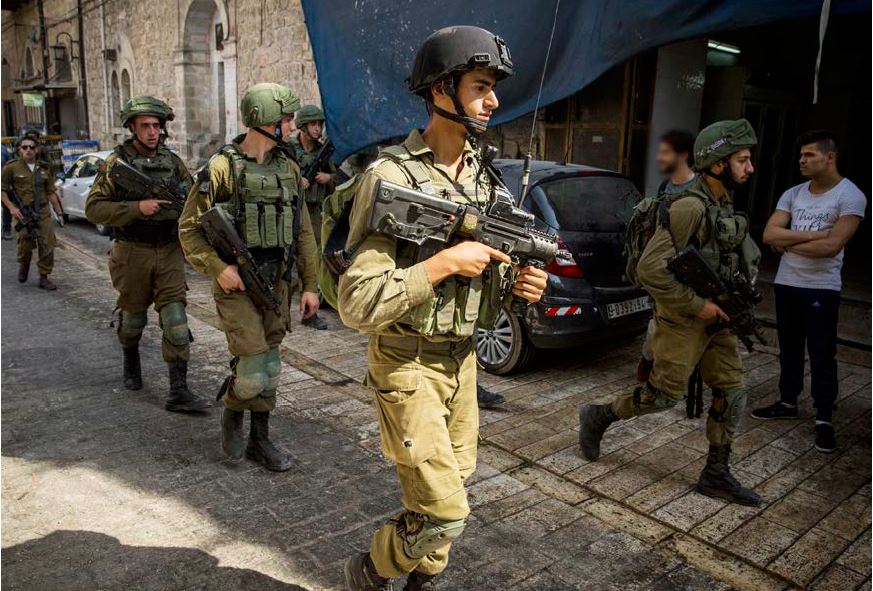THE ISRAELI OCCUPATION
There are some 3 million Palestinians and around 600,000 Israeli settlers living in the West Bank, an area which includes East Jerusalem.16 Israel captured the West Bank, as well as the Gaza Strip, duringa war with its Arab neighbours in 1967.17 These areas are known today as the Occupied Palestinian Territories (OPT).
Since the start of the occupation, Israel has administered different parts of the OPT in different ways. In 1967 Israel unilaterally annexed East Jerusalem and included these Palestinian parts of the city, as well as a surrounding area of over 70km2, within the boundaries of the Israeli municipality of Jerusalem.
The Israeli military governed the remainder of the West Bank, as well as the Gaza Strip, as occupied territory from 1967 onwards.
This changed in the mid-1990s following the Oslo Accords. These established the Palestinian Authority (the PA, now known as the State of Palestine) and divided the West Bank excluding East Jerusalem into Areas A, B and C. The Oslo Accords transferred partial jurisdiction of some areas to the PA, while overall security remained under Israeli control. As a result, the PA obtained varying amounts of administrative responsibility over Areas A and B. These areas included Palestinian towns and villages where 90% of the Palestinian population lived. Meanwhile, Palestinian rural areas were classified as Area C, where Israel maintained full civil and security authority. A separate agreement saw the division of the city of Hebron into Palestinian and Israeli-administered sectors, known as H1 and H2 respectively.
The Oslo Accords were intended to act as a “transitional arrangement lasting not exceeding five years”. However, its terms and implications remain in force today.

SETTLEMENTS IN THE WEST BANK
Since 1967, it has been Israeli government policy to promote the creation and expansion of Israeli settlements in the OPT. Successive governments have implemented this policy through a combination of legal and administrative measures. They have also provided subsidies, tax incentives and lowcost utilities and resources to encourage Jewish Israelis to live in these places and to support the settlement economy. Israeli settlements in the OPT are meant to be permanent places of residence or economic activity for Jewish Israelis and are built with the sole purpose of serving their needs. There are now approximately 250 settlements. Some have fewer than 100 residents. Others, such as Ma’ale Adumim, which has a population of about 37,000, are well-resourced towns.
Settlements are spread throughout the West Bank, connected by a network of roads. They surround all the major Palestinian cities and many towns and villages. Most settlers live in Area C of the West Bank, but about a third – 200,000 – are in East Jerusalem. Most of those in East Jerusalem live in neighbourhoods and suburbs that Israel constructed after 1967. Others have taken over hundreds of buildings within Palestinian neighbourhoods in East Jerusalem. Similarly, several hundred Israelis have moved into buildings and homes in the Israeli-administered area of Hebron’s city centre known as H2.
Settlements are much more than residential colonies. The land controlled by settlers covers more than 53,000 hectares – or roughly 60% of Area C. This includes 20 industrial zones and an estimated 9,300 hectares of agricultural land. Movement restrictions imposed by the Israeli military, supposedly for security reasons, mean that over 400km of roads that connect the settlements are not accessible orare only partially accessible to Palestinians.
The Israeli government has built 85% of its 700km-long “Separation Barrier”, which it presents as separating Israel from the West Bank, within the West Bank. This surrounds many Israeli settlements and effectively bars thousands of Palestinians from their land. It has also designated large chunks of Area C as military zones (30%) or nature reserves and parks (14.5%), further blocking Palestinians’ access to their land.
THE ROLE OF BUSINESSES
An independent fact-finding mission, mandated by the UN Human Rights Council to investigate the human rights implications of the Israeli settlements in the OPT, reported in 2013 on how a range of business activities, involving both Israeli and foreign companies, sustains settlements. The report also flagged concerns relating to the impact of these business operations on the civil, political, economic, social and cultural rights of the local Palestinian population. Based on this report, the Human Rights Council requested that the UN Office of the High Commissioner for Human Rights (OHCHR) create a database of business enterprises involved in certain activities in the settlements. A progress report, published in 2018, noted that tourism activities “ensure the sustainability of residential settlement communities” and “contribute to the profitability of the settlements”.

